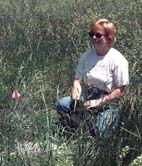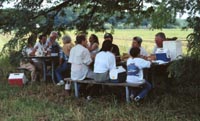
"We as a nation and as individuals are much defined and explained by the great empty middle of our continent, which is the grassland."
- from Richard Manning’s Grassland
Perhaps people who live on land that was once prairie have special connections to the land. This is why many people bring different ideas and skills to preserve, protect, and try to understand the prairie.
Conservation groups, prairie societies, school groups, scouts, and others volunteer their time to help preserve and restore prairies. Teachers use prairies as hands-on learning situations for their students. Property owners donate or designate land to be preserved in the future. These are just a few examples of ways in which people support Illinois prairies.

 2
2 
Images
1. Volunteer preparing for Mighty Acorns at Midewin NTP
2. Teacher seated near gopher burrow at Midewin NTP
3. Volunteers at Midewin NTP
An ecologist usually is in charge of the entire site. S/he is responsible for overseeing any decisions made, and selecting people who understand the unique prairie ecosystem.
A botanist usually helps to select the appropriate plants that should be planted on the site. S/he understands the specific requirements that each plant will need to be able to thrive.
Ornithologists help to understand the species of birds that exist on the site before and after a site has been restored. S/he can help to decide what plants will maintain an environment that is good for grassland birds.
Mammologists study the mammals that use prairies as their home. By understanding the type of habitat animals use, their knowledge is useful when selecting a site and later in maintaining a population of animals.
Educators work with school children, families, young adults, seniors, and volunteers to help them understand the dynamic interactions of plants and animals that occur on prairies. By doing this, educators are able to provide an environment where people learn to respect and protect prairie ecosystems.
Volunteers are necessary to the success of a project. In the beginning, volunteers put in many long hours planting, collecting seeds, and even helping with the burning of the prairie. By communicating their enthusiasm for prairies they help visitors understand the importance of caring for prairie ecosystems.
|
|
Copyright © 2000 Illinois State Museum